HoC - Roll of Honour - Robert Dudley Gidley
HOME PAGE -- ROLL OF HONOUR -- CHISWICK’S MEMORIALS
-- RESEARCH EXHIBITS -- PEOPLE AND PARISH -- CONTACT US
Stawell William Wade Garnett -- Geoffrey Damerel Gidley -- Robert Dudley Gidley -- Horace Walter Hardy -- Wilfred Hitching
Robert Dudley Gidley
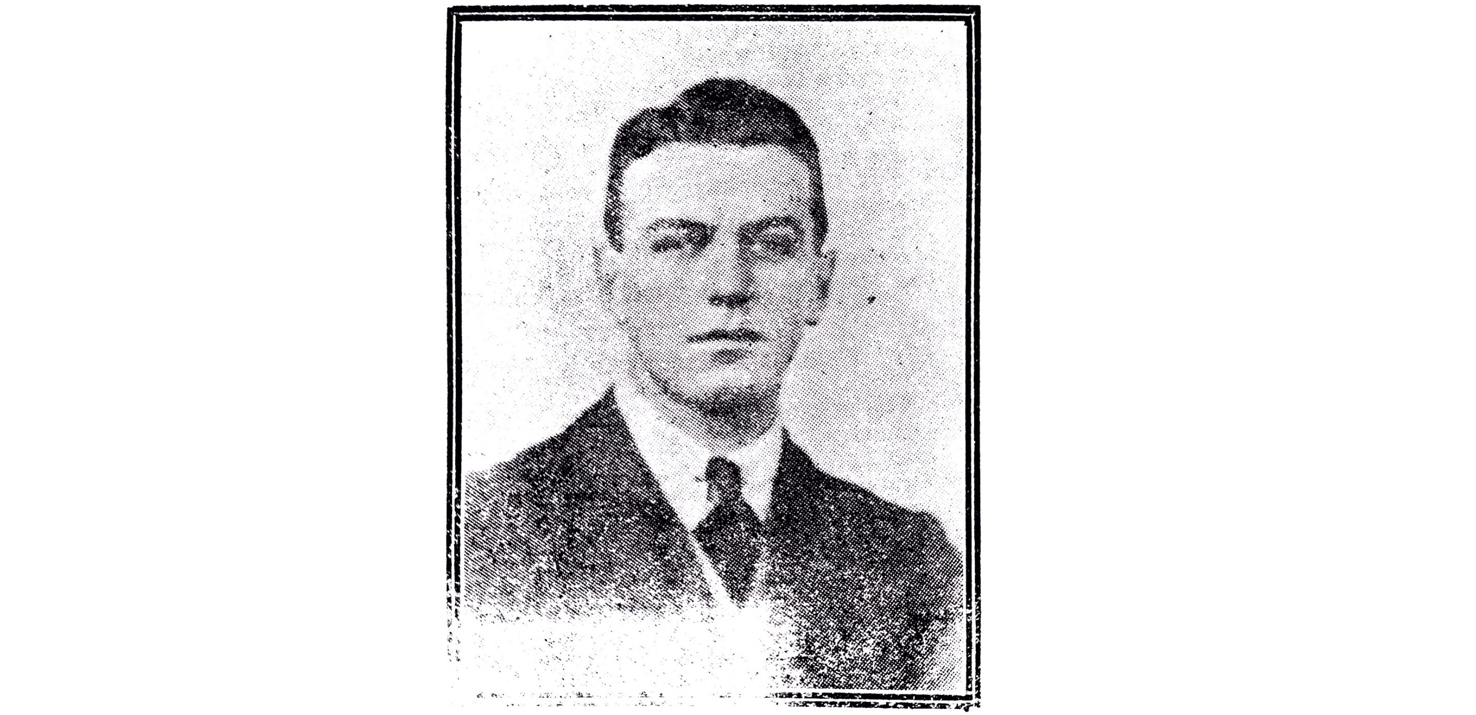
Robert Dudley (“Bob”) Gidley was born on 19 February 1900 in Shepherd’s Bush, the youngest son of George Gidley (1862-1935) and Annie Maud Gidley (nee Sharp, 1862-1948). He was christened at St Stephen’s Church, Shepherd’s Bush on 26 March 1900. At that time, the family were living at 51 Pennard Road, Shepherd’s Bush. The family were still living at 51 Pennard Road at the time of the 1911 census. More details of the Gidley family are included in the biography of Geoffrey Damarel Gidley.
Sometime between 1911 and 1913, the Gidley family moved to 10 Burnaby Gardens. Like his elder brother Geoffrey, Bob was a keen scout with the Third Chiswick Troop. Much of the following account of his life is taken from his entry in “The Scouts Book of Heroes”, which starts:
“To all true Scouts the war brought an irresistible call to the service of King and Country. Those whom youth or ill-health prevented from “joining up” were bitterly disappointed, and many a story is told of the ways in which they tried to evade the authorities, and get out to do their bit. Perhaps few stories could equal that of Bob Gidley, for heroic perseverance.
Bob Gidley had a remarkable career which was an example and inspiration to his brother Scouts. He joined the Chiswick Troop before he was twelve and remained a member of it throughout. He was a somewhat delicate and reserved boy, but his sterling worth was shown at the age of thirteen when he saved a child from drowning, at Strand on the Green”
The first reference to the rescue by Bob Gidley is contained in the Chiswick Times from 29 August 1913:
“The circumstances in which Scout R. Gidley saved a child from drowning recently at Strand-on-the-Green has been brought to the notice of headquarters, and the question of the award of a medal of merit is now under consideration."
The outcome of those considerations was shown in the account in the Chiswick Times of 5 December 1913, where it notes on the front page that:
"A concert, arranged by the 3rd Chiswick Troop of Boy Scouts, was given at the Town Hall on Tuesday, and badges were presented, and also a life-saving medal to Scout Gidley, who rescued a child from drowning"
Further details of the prize-giving were contained on p6 of the same edition:
"A lady, who was unknown to him, had written to him some time ago as she had seen a child rescued from drowning by a boy who she believed was in his troop. After much difficulty he succeeded in getting information and found that the child, who was floating unconscious in the Thames at Strand-on-the-Green, owed his life to the presence of mind of Scout Robert Gidley (cheers). The chief scout had awarded a certificate of merit to Scout Gidley in recognition of his action, and Her Highness Princess Alexandra of Teck had promised to visit Chiswick in a few months to present the award (loud cheers)"
The promise was in fact kept by Prince Alexander of Teck at Chiswick Town Hall on 23 February 1914. The account of the event recounted in The Chiswick Times gives details of the displays presented to Price Alexander, which included a musical drill presented by the 3rd Chiswick Troop; a squad unlimbering a 320lb wagon and putting it together again “very smartly” and a signalling display. In turning to the principal event of the evening, the Chiswick Times goes on to a speech by Mr Martin giving further details of the story:
“It appeared that the child, Queenie Farndon, aged three years, of Thames Road, Chiswick .. fell into the water at Strand-on-the-Green, and was noticed by Scout Gidley under the water lying on her face in a practically unconscious condition and in grave danger of being carried into the stream. Gidley, by his presence of mind and promptitude, got the child out, applied artificial respiration, took the child home, and – said nothing about it (loud cheers).
Mr. Martin then led the young scout – he is only 14 years of age – through the lines of his comrades, manifestly proud of him, though he was now a little nervous – to the dais where Prince Alexander handed him the framed certificate, with the words “You have done a great scout action. I hope you will do many more in the future.”
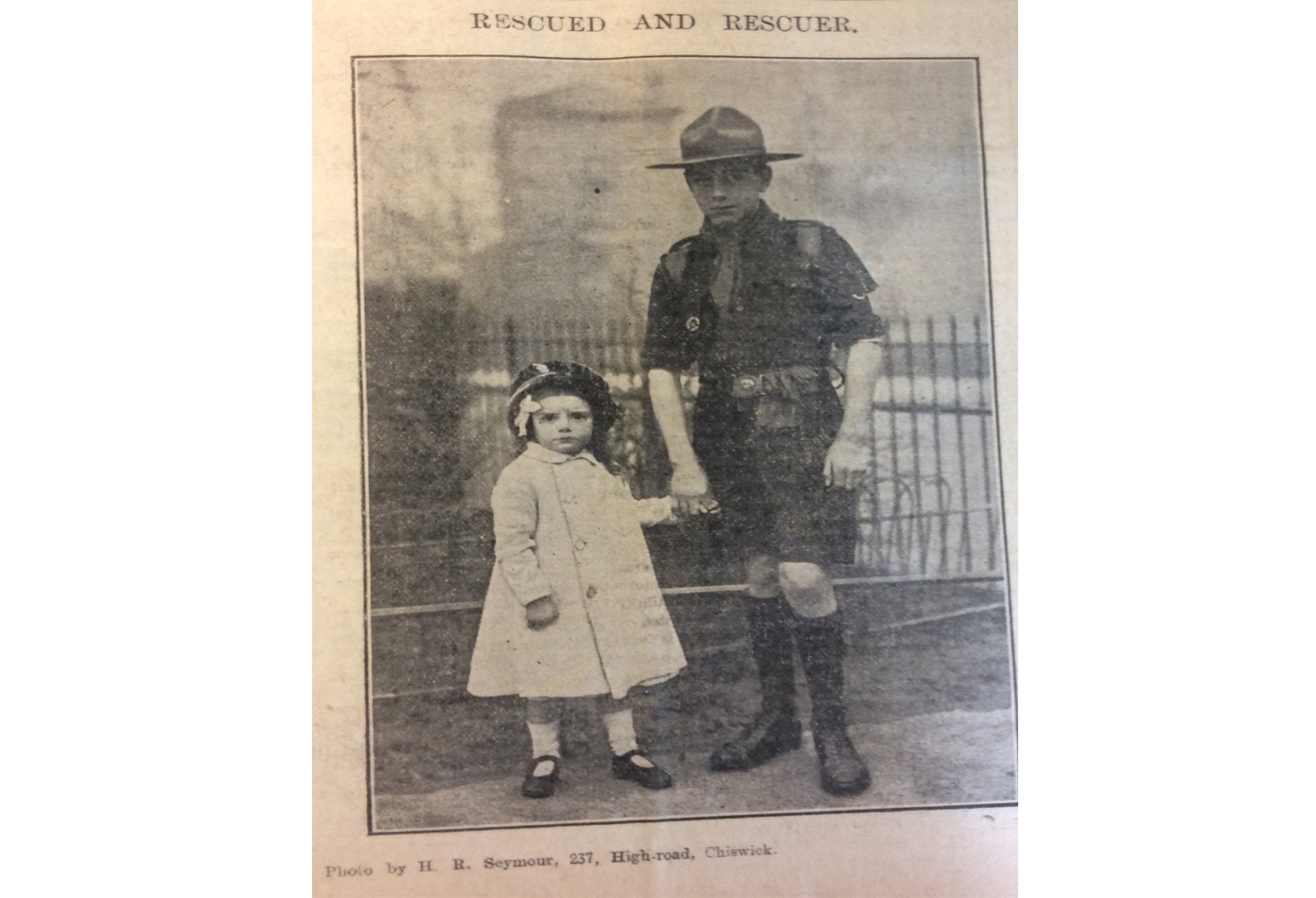
“The Scouts Book of Heroes” then takes up the story:
“In July 1914, Bob was in Belgium with a party of Scouts, and was in that country when it was invaded by the Germans. Returning home he immediately volunteered for Scout war service, and served in the Foreign Office for several months.”
Then, on 16 April 1915, aged just 15, but claiming to be 19, he enlisted in the Royal Naval Air Service. On enlistment, he was described as 5 foot 6 ½, with a 36 inch chest, dark hair, blue eyes and a fresh complexion. According to “The Scout’s Book of Heroes”, he joined the RNAS as a motor despatch rider, and was transferred to the armoured car section. He was promoted to be 1st class petty officer, and later on qualified as pilot’s observer and made several ascents. After fourteen months’ service, he was recommended for a commission in the Army, and was sent to the Officer’s Cadet Battalion at Oxford.
His service records (Soldier’s Documents from Pension Claims, TNA, WO364/1343) show that he enlisted at Whitehall on 23 May 1916. Bob was then 16, but claimed on his enlistment form to be 20. His height at that time had apparently increased to 5 foot 8.
His service records include a message dated 8 January 1917 from the Office i/c T F Reserve Office to the War Office:
“I beg to report that application has been received for the discharge of No.6142 Cadet R.D. Gidley, 9th Reserve Battalion, London Regiment, at present serving with No.4 Officer Cadet Battalion, on the ground of age (date of birth 19.2.1900) and shall be glad to receive your instructions in this matter.”
The “Scouts Book of Heroes” gives the background to this as follows:
“He was there [Officer’s Cadet Battalion] some six months, but the training was so severe that he broke down in health, and his age – then only 16 years and 10 months – was discovered.”
Somewhat surprisingly, contained amongst all the official communications in Bob’s service records, is a letter that his mother wrote to him, from “Lyndhurst”, Burnaby Gardens, dated 1 January 1917:
“My Darling Boy,
Now that you are back in camp again what are you doing about your discharge.
I am anxious to know whether you are coming home soon.
It is no good your trying to go on. You will only strain yourself again and perhaps permanently.
I told you at first that you would not be strong enough for soldiering. You have outgrown your strength so much.
After all the sickness you had in hospital last year perhaps you now know I was right.
When you were last in hospital early in December I sent you your birth certificate and asked you to use it to get your discharge. I thought they would discharge you directly they saw it.
In any case you have done your bit so you can surely wait until you are 18.
Until then you can do other useful work and at the same time get strong.
With dearest love and God bless and be with you and grant you a Happy New Year
Your ever loving Mother”
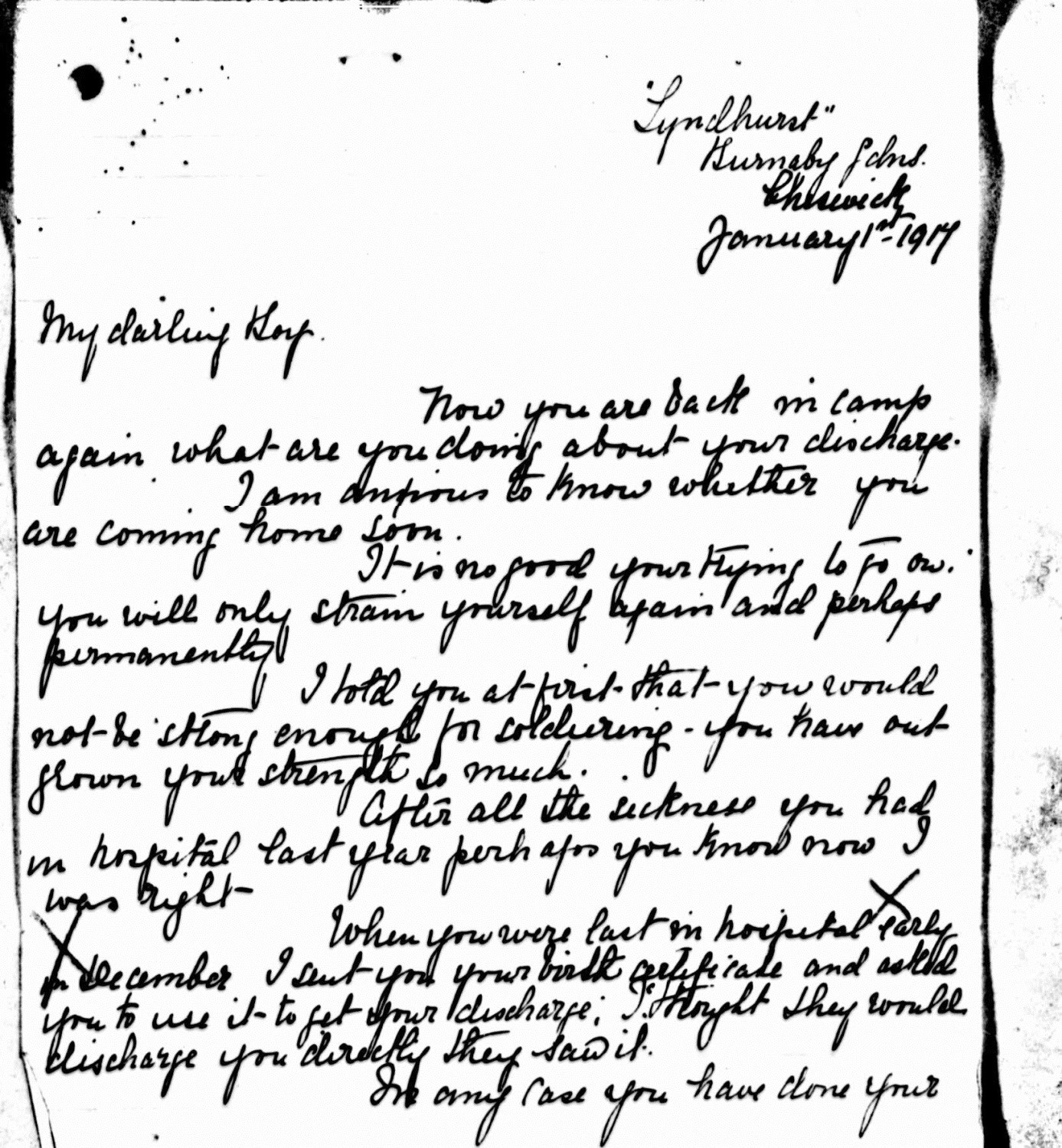
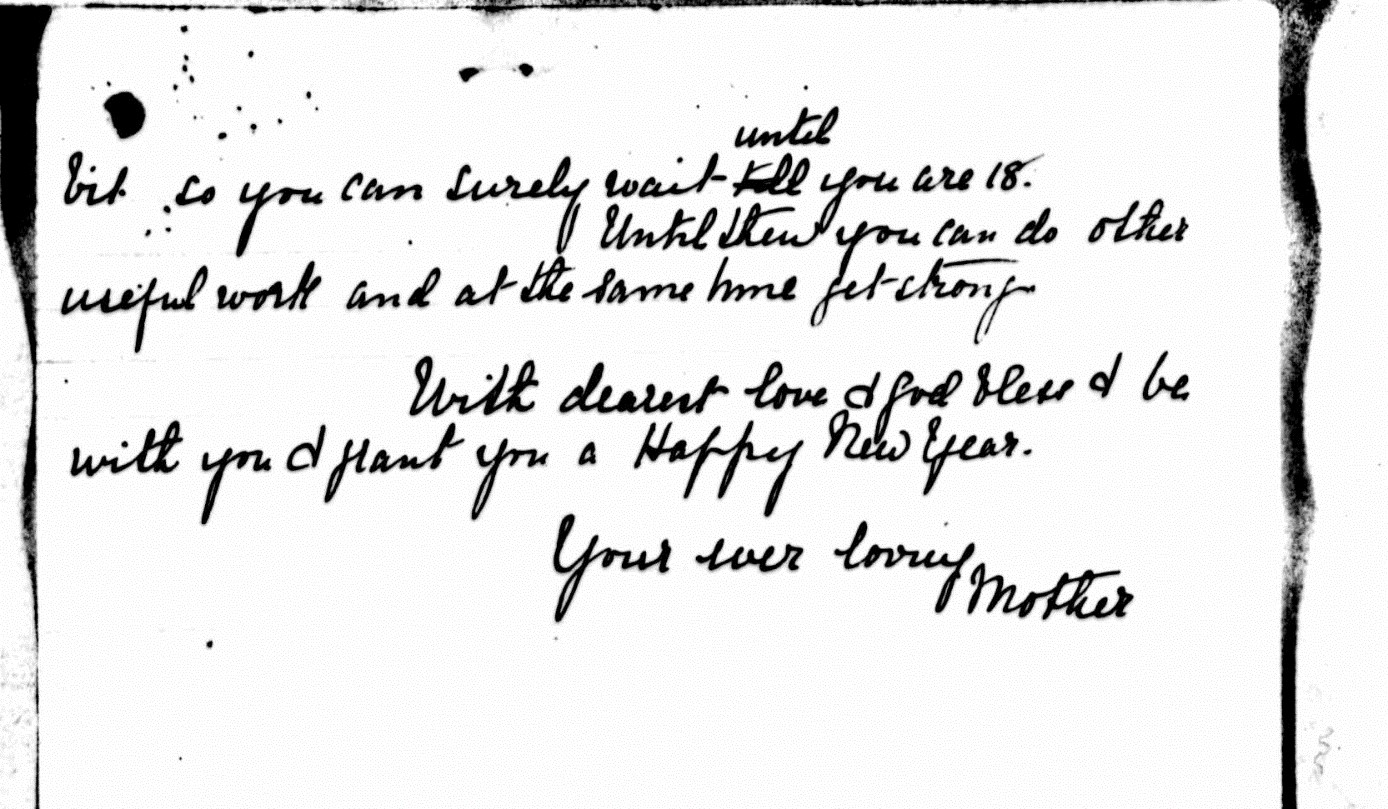
It seems that Bob had taken his mother’s advice regarding his birth certificate, as the first communication on the file regarding his discharge is dated 16 December 1916. There were then a string of official communications as to whether Bob could be discharged, and what should be done with him (on 29 January 1917: “If Private Gidley is willing to enrol as an Army Reserve Munition worker, he should be posted to Detachment Depot. H.A.C. If not, please post him to 9th Reserve Bn, London Regiment, for transfer, in due course, to 69th Division…” followed by, on 2 February 1917: “The discharge of this man cannot be sanctioned…”) until his discharge was finally authorised, on 10 February 1917, under King’s Regulations paragraph 392(xxv). Even then, his discharge was delayed due to the fact he was suffering from German measles. His discharge from the Army finally took effect on 17 March 1917 (by which time he had grown to 5 foot 10½).
It is at this point that Bob’s “heroic perseverance” came to the fore. According the the “History of the Third Chiswick Scouts”, Bob said to DSM (District Scout Master) Mr H.S.Martin “I can drive a car – why not an ambulance?”.
On 27 March 1917, Bob sailed to France as part of the Section Sanitaire Ecossaise 20 (also known as the “Scottish Convoy”), attached to the French Red Cross, and to quote from a report in the Chiswick Times of 4 May 1917: “After only a few weeks’ service his brilliant and self-sacrificing career was crowned by a most gallant death in the service of others”.
The Chiswick Times goes on to quote a letter from the Director General of the French Red Cross:
“I beg to convey to you the most respectful expression of sympathy in your irretrievable loss from His Excellency the French Ambassador, from la Vicomtesse de la Panouse, and from every member of the executive here. During the time that your son was at this office he gave every token of being a most valuable recruit. On his arrival in France he immediately gave proof of this by setting about his duties in the most efficient and spirited way, and his place will indeed be hard to fill. The convoy was at work with the French forces engaged in the recent great assault, and the work done by this ambulance column was necessarily of a hazardous character, only to be undertaken by those endowed with both nerve and pluck. In this noble work of rescuing the fallen, and with self-sacrifice worthy of the best traditions .., your son has made the supreme sacrifice, and we bow in homage to his memory.”
“The Scouts Book of Heroes” gives more details of how Bob died:
“Not the least dangerous part and trying part of the work was that of driving the ambulance cars from the small town where the section was stationed, up to the front. The road was frequently shelled by the Germans, and, the journey once started, there was, of course, no means of taking cover.
One day, as Gidley, accompanied by one other man, was driving a car along this dangerous road, a fierce bombardment began. They put on their helmets and continued bravely to speed on towards the line. But the fire became so intense that they were obliged to halt with a view to drawing back, a little, and trying to find some cover.
Gidley had just commenced to back the car, when, with a terrific explosion, a shell burst exactly in front of them and the glass windscreen was blown into a hundred pieces. Gidley’s companion, though shaken by the concussion, was unhurt, and thought at first that his friend had not received any injuries, either, as he remained sitting in his place, and the car continued to back. But it soon became evident that the brave young driver was unconscious and that he had received some terrible wounds in the head and neck.
The shells were coming over every few seconds, and the other ambulance man decided that the wisest thing to do was to try to back the car into a safer position. This he did for some sixty yards, when the back wheels collapsed, and the car came to a standstill. With the help of some French soldiers and another ambulance, the brave young Scout was taken back to the hospital, where half an hour afterwards he died.”
The death certificate issued by the French authorities (TNA, General Register Office - Miscellaneous Foreign Death Returns, RG35/45) states that Robert Dudley Gidley died on 26 April 1917 at Chateau de Nantivet, Suippes, Marne “des suites de blessures de guerre [following war wounds] – Mort pour la France”.
On 11 May 1917, the Chiswick Times gave further details of the circumstances of Bob’s death, reporting that the ambulance driver who had been due to drive that day had been taken ill, and Bob Gidley volunteered to take his place. The report also stated that the French Croix de Guerre had been conferred on the late Scout Gidley as a mark of his devotion to duty. The decoration was pinned to the flag covering the coffin, and has now been forwarded to Mr. and Mrs. Gidley.
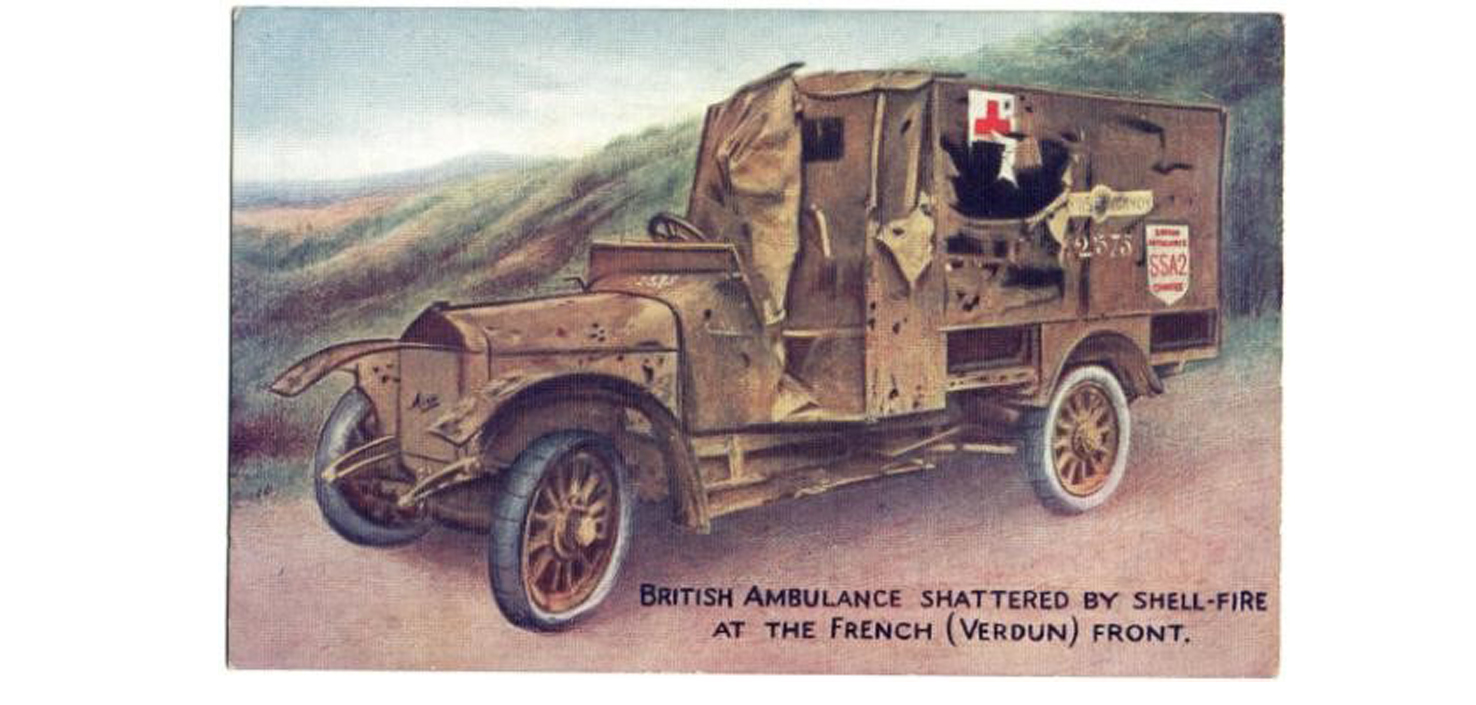
(Image taken from http://www.worldwar1postcards.com/ambulance-car.php)
The Chiswick Times of 18 May 1917 carried a lengthy report on his memorial service, including the photo that is included at the start of this biography.
The report of the memorial service says it was “very largely attended”, which seems a bit of an understatement. The service was held at St Michael and All Angels, Bedford Park: all 5 of the Chiswick scout troops attended, and a guard of honour was provided by the 10th Battalion Middlesex cadets. The French Red Cross was represented by Madame la Vicomtesse de la Panouse (Presidente) as well as its Director General, and there were also representatives from the French Embassy and the Foreign Office. The Foreign Office, in which Robert Gidley had served on voluntary service was represented by Councillor H.S. Martin (chief passport officer).
The family members included his parents, sisters, and his brother Julian.
“The service opened with a verse of the National Anthem, sung kneeling. Then followed the psalm, “Lord, thou hast been our refuge”, sung to plainsong, whilst the lesson from the burial service was read by Assistant County Commander H.S. Martin. The latest scout’s favourite hymns were used, “Nearer, my God to Thee”, “How bright those glorious spirits shine”, and “For all the saints”.
The address was given by Rev J. Cartmel-Robinson, reported by the Chiswick Times as follows:
“He remembered it being said of Scout Gidley, whose name they associated that day in their memory with France and England – that he was fearful of the [sic – one?] thing. He was a good Churchman, and said, “When I go to France I wonder if they will admit me to holy mass? I should like to make my communion.” Scout Gidley gave his life for the cause, and he was quite certain that whether he received holy communion from a priest of France or whether he did not, his act of self-sacrifice was well-pleasing to God, and was enough, enough for God, as they felt it was enough for them. And so that day they thought of Robert Gidley giving his life for France, and they felt that somewhere in the fields of France, on what the French of the old days would call the Field of Honour, a great sacrament had been given, a sacrament of the body and blood and of the best of both countries. Might that sacrament be to them a reminder of their perpetual union and strength. God bless France. God bless England. Together they stood for the amelioration of the condition of society throughout the world, that this generation might leave the world just a bit better, sweeter, and more beautiful than they found it.
Then from the organ swelled out the inspiring strains of the Marsellaise, followed by the sombre passages of Chopin’s “Marche Funebre”, both being impressively played by Mr Hurst Bannister, the organist. A pause, and from the side chapel came two rolls on the drum, increasing in volume, with two sharp gun-like traps at the end. Then a soldier’s farewell to a soldier comrade, the “Last Post”, sounded by the bugle, Senior Patrol Leader L. Westbury and Patrol Leader Geddis, of the 2nd Chiswick, performing this office.”
The writer of the report of Robert Dudley’s death in the 4 May 1917 edition of Chiswick Times is anonymous, but was clearly a fellow Scout (having been part of the party of scouts in Belgium with him) and wrote:
“Bob Gidley was possessed of a sweetness of disposition which, combined with a remarkable manliness for his years, gained him the affection of all those who knew him. To the writer the boy’s life was an inspiration, the memory of which will live long in the minds of those who had the privilege of his friendship. If every scout in Chiswick will but keep before his eyes the example of this very gallant gentleman, Bob Gidley’s life and death will not be in vain.”
Robert Dudley Gidley is buried in Suippes French national cemetery. He is the only Englishman in 4500 French graves.
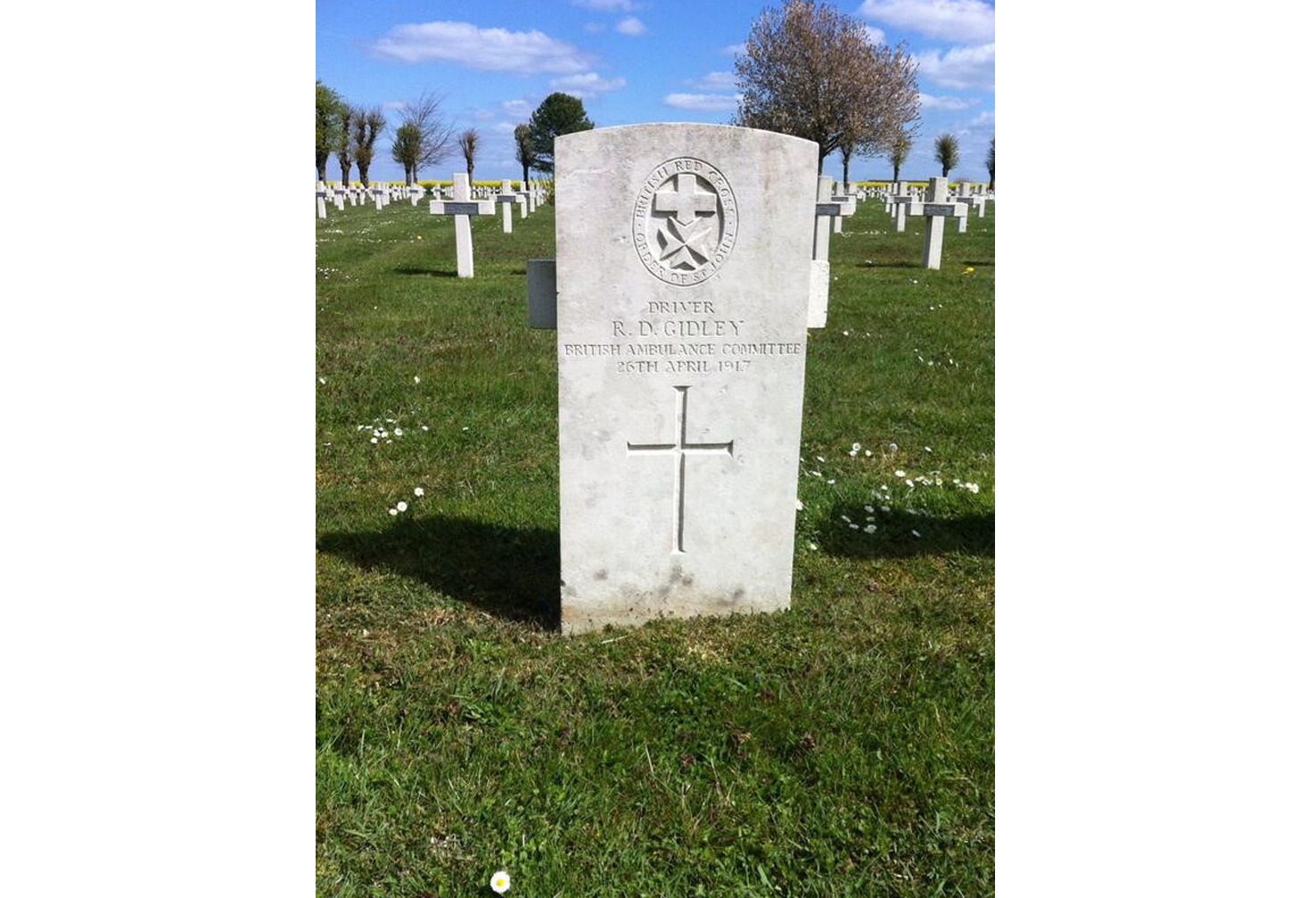
(Photo: Prof Peter Doyle)
SOURCES
“The Scouts Book of Heroes”, from www.thedump.scoutscan.com
Soldier’s Documents from Pension Claims, TNA, WO364/1343
TNA, General Register Office - Miscellaneous Foreign Death Returns, RG35/45
With thanks to Prof Peter Doyle for the photo of R. Gidley’s grave, and Paul Reed who also offered to assist.